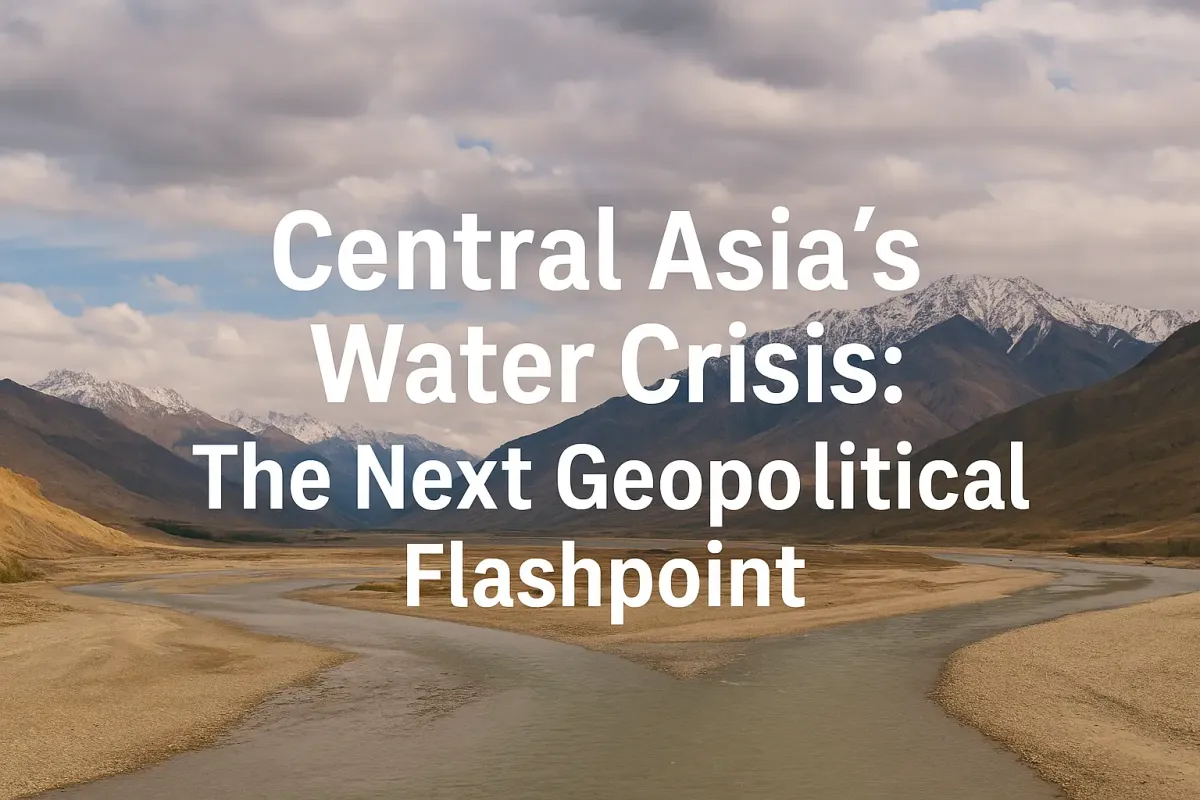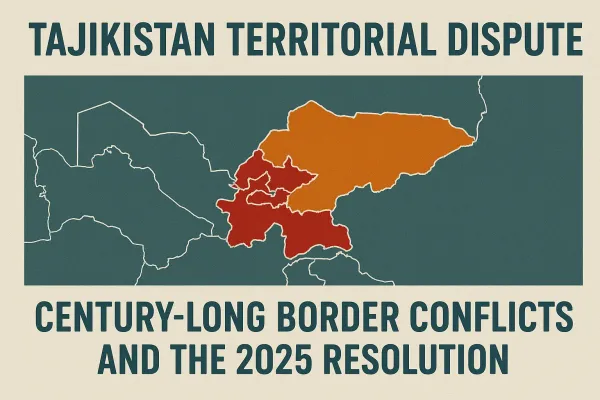Central Asian Water Diplomacy: Rising Tensions and the Fight for Regional Stability
As glaciers melt and rivers shrink, Central Asia is entering a new era of water wars. What began as a climate challenge is fast becoming a geopolitical fault line — testing fragile borders, alliances, and the future of regional stability.

While the world watches flashpoints in the Middle East and Eastern Europe, Central Asia is sliding toward a water crisis that could redraw the region's political map. Two rivers—the Amu Darya and Syr Darya—keep 75 million people alive across five countries, but these waterways have become sites of bitter conflict. Countries upstream want to build dams for electricity while nations downstream watch their farms dry up from lack of water.
The real danger isn't just shrinking water supplies. It's what happens when you mix water scarcity with unresolved territorial disputes left over from Soviet times and add a complete absence of anyone with the power to force these countries to work together. The combination is explosive, and the fuse is already lit
Afghanistan’s Qosh Tepa Canal: The Game-Changer in Central Asia’s Water Crisis
Afghanistan's Qosh Tepa Canal has become the single biggest threat to regional water security. The Taliban made this 285-kilometer project a top priority after taking power in 2021, and construction has moved at shocking speed—by October 2025, excavation reached 95% completion. When this canal goes live, it will pull roughly one-third of the Amu Darya's flow to water 550,000 hectares of Afghan farmland. That water has to come from somewhere, and the "somewhere" is Uzbekistan's cotton fields and Turkmenistan's desert agriculture.
The Taliban hasn't signed a single water agreement with neighbouring countries and shows zero interest in doing so. Three downstream nations—Kazakhstan, Uzbekistan, and Turkmenistan—issued stern warnings in May 2025, but warnings mean nothing without muscle to back them up. These countries can't force Afghanistan to negotiate. They lack the military power, and the international community isn't interested in getting involved.
What's striking is that both sides have legitimate grievances. Afghanistan is one of the planet's most water-stressed countries and desperately needs this canal to feed its population. From Kabul's view, using water that flows through Afghan soil is a sovereign right, not an act of war. Downstream nations see it as outright theft of resources they depend on for survival. Without Afghanistan participating in any regional water institutions, there's nobody neutral to referee this fight.
🌍 Related Insight: The same forces driving Central Asia’s crisis—shrinking rivers, political fragmentation, and climate stress—are already reshaping power dynamics in the Middle East.
The Upstream–Downstream Dilemma: How Geography Fuels Central Asia’s Water Conflicts
Central Asia's water crisis boils down to geography and opposing needs that can't be reconciled. Kyrgyzstan and Tajikistan sit at the top of the mountains where both major rivers begin, and they're starving for electricity. Their power grids, built during Soviet times, are falling apart. Hydroelectric dams offer the fastest, cheapest way to keep the lights on. Meanwhile, Kazakhstan, Uzbekistan, and Turkmenistan downstream depend entirely on summer water flows to irrigate the massive farming systems they inherited when the USSR collapsed.
Tajikistan's Rogun Dam perfectly illustrates the problem. At 335 meters, it's becoming the world's tallest dam, with enough generating capacity—3,600 megawatts—to double the country's electricity production. About 70% of Tajikistan's population experiences blackouts during winter, so this project matters. But here's the catch: power plants make the most electricity when people need heating in winter, which requires releasing huge amounts of water exactly when downstream farmers don't need it. Come summer, when crops are dying for water, electricity demand drops and the dam holds back flow.
Both sides have valid claims. Upstream countries have every right to develop hydroelectric power within their borders. Downstream countries genuinely face agricultural collapse if water timing shifts too dramatically. Usually, conflicts like this get resolved through power dynamics—stronger downstream nations offer security guarantees or economic incentives to get upstream neighbours to cooperate. Central Asia flips this script completely. The upstream countries actually have stronger militaries, which means Kazakhstan, Uzbekistan, and Turkmenistan can't credibly threaten force to protect their water access. Kyrgyzstan and Tajikistan face no real consequences for building dams however they want.
When Water Turns to War: Kyrgyzstan–Tajikistan Clashes and the Fergana Valley Crisis
In September 2022, Kyrgyzstan and Tajikistan went to war over water. The fighting along their disputed border in the Fergana Valley marked the worst violence between the two countries since they gained independence. At the center of the conflict sat the Vorukh enclave—a chunk of Tajik territory completely surrounded by Kyrgyz land, blessed with rich soil and reliable water access that made it worth fighting for.
This wasn't new. Similar clashes erupted in 2014 at critical water sources, revealing a dangerous pattern: when water runs short, people start shooting. The 2022 violence displaced thousands and left confirmed dead on both sides. What scared observers most was how quickly things escalated—local arguments over water infrastructure turned into full military mobilizations with artillery exchanges.
The Fergana Valley's bizarre geography practically guarantees conflict. Soviet bureaucrats drew borders with no regard for who actually lived where or how water flowed, creating a jigsaw puzzle of enclaves and exclaves. These territorial oddities work fine when water is abundant. When it's scarce, they become killing grounds where no existing legal framework can resolve who controls what.
The March 2025 Hujand Declaration offered the first real hope. Tajikistan, Kyrgyzstan, and Uzbekistan signed a trilateral agreement explicitly tying border settlements to water management and energy access—finally admitting these issues can't be separated. Whether it actually works remains to be seen. The agreement hasn't faced a real test under genuine scarcity conditions yet.
From Soviet Cooperation to Chaos: The Collapse of Central Asia’s Water Management System
To understand today's water chaos, you need to know what existed before. During Soviet times, Moscow ran Central Asia as one giant farm where water flowed according to a master plan. Upstream republics released water when downstream farmers needed it, and in return Moscow sent them subsidized coal, gas, and electricity to make up for the hydroelectric power they sacrificed. The system worked because the Kremlin had the power to make everyone comply.
Independence killed this overnight. A 1998 agreement tried to keep the water-energy trades going, but without Moscow's muscle, it collapsed immediately. When Kazakhstan didn't deliver promised energy in 1999, Kyrgyzstan retaliated by cutting water releases—showing exactly how fast cooperation unravels when nobody can enforce the rules. That same year, Uzbekistan put 130,000 troops on the Kyrgyz border, marking the first time water disputes became military standoffs.
The Interstate Commission for Water Coordination was supposed to coordinate water use, but it had zero enforcement power. During wet years, everything looked fine because plenty of water covered up the dysfunction. Dry years revealed the truth—the agreements were worthless. No dispute resolution, no flexibility for droughts, no penalties for countries that ignored the rules and built dams anyway.
What followed was inevitable. Downstream countries started building their own reservoirs to grab water before it crossed borders. Upstream countries rushed dam construction without environmental studies or asking neighbours. Every move triggered retaliation, creating a downward spiral where cooperation became impossible. The Aral Sea shows what happens when this system fails completely—Soviet irrigation projects drained it by 92%, destroyed the fishing industry, and turned the dry seabed into a source of toxic dust storms.
🌏 The Indo-Pacific's Pragmatic Power Play
Countries across Asia are refusing to pick sides between Washington and Beijing, building flexible partnerships instead. See how this pragmatism reshapes regional power—and why the water-starved Middle East can't adopt the same approach.
→ Read: The Indo-Pacific in 2025: Power, Pragmatism, and the Search for Balance
Climate Change: The Ultimate Threat Multiplier in Central Asia’s Water Security
If Central Asia's water supply stayed constant, these political disputes might be manageable. But climate change is rewriting the region's entire water system in ways that make conflict inevitable. The Pamir and Tien Shan glaciers feed both major rivers and supply roughly 80% of Central Asia's water—and they're melting 65% faster than a decade ago. If this continues, half the region's glacial ice could vanish by 2100.
The melting creates a cruel illusion. Right now, faster glacier melt actually increases water flow temporarily, making some countries think there's no crisis. This timing disaster means countries with current abundance see no reason to negotiate sharing agreements, while those already struggling view the temporary surplus elsewhere as meaningless. Everyone's missing the window to act before the glaciers disappear completely.
Meanwhile, rising temperatures make farms need more water just to grow the same crops. Irrigation systems built for cooler times now pour out proportionally more water for lower yields. The 2021 drought hit over 40% of the region with severe shortages, crop failures, and massive livestock deaths. A March 2025 heatwave struck during flowering season for Uzbekistan's fruit crops and Kazakhstan's wheat, likely crushing yields.
Weather patterns have shifted from predictable seasons to chaotic extremes. Farmers who relied on spring snowmelt now face completely erratic timing that either kills crops or floods fields. This makes planning new infrastructure nearly impossible—by the time a dam gets built, the water patterns it was designed for may no longer exist.
Failed Cooperation and Regional Diplomacy: Why Central Asia Can’t Solve Its Water Crisis
International development organizations have pushed Integrated Water Resources Management as the cure for Central Asia's water wars. The IWRM approach sounds good in theory—manage water by watershed boundaries instead of political borders, let local stakeholders participate in decisions, reduce government monopolies over allocation. Projects implementing these principles over the past 15 years have achieved real technical improvements across roughly a million hectares.
The problem isn't the technology—it's politics. IWRM requires governments to hand management control from their ministries to watershed-based authorities, fundamentally restructuring institutions that represent national sovereignty. It means empowering local water user groups to manage resources directly, which governments hate because it challenges their control over strategic assets. Building local capacity takes years while water crises explode in months.
Individual countries have made progress. Kazakhstan modernized canals and introduced drip irrigation. Uzbekistan removed water subsidies for cotton and promoted crop diversification. These national efforts help but can't solve basin-wide problems that require all countries working together.
Bilateral partnerships address specific issues but create new problems. When two countries cooperate, they exclude others who share the same rivers, potentially making coordination worse even as they fix localized challenges. What's needed is all river basin states participating in binding frameworks with enforceable rules and neutral dispute resolution—exactly what Central Asia doesn't have.
Major powers won't mediate. China has massive economic leverage through Belt and Road investments but refuses to get involved in water disputes, fearing it will damage relationships with individual countries. Russia and the United States also avoid mediating despite their regional influence, prioritizing trade over environmental security. Everyone's leaving Central Asian nations to fight it out alone.
The Road Ahead: Can Central Asia Prevent a Full-Blown Water War?
Everything's coming to a head at once. Afghanistan's canal will be operational soon, glaciers are melting faster than predicted, and nobody's in charge—this combination could blow up into a regional crisis within the next few years. The March 2025 agreement between Kyrgyzstan, Tajikistan, and Uzbekistan might help, but nobody knows if it'll actually work when water runs short. Here's the killer: Afghanistan isn't part of any of these agreements, which means the Qosh Tepa Canal will operate with zero oversight, and downstream countries will lose water no matter what they do.
The migration crisis nobody's talking about is what really worries we. When farms fail and people can't grow food, they have two choices—starve or leave. The World Bank says 5 million Central Asians could become climate refugees by 2050, but where do they go? Cities don't have jobs for them, and countries everywhere are slamming their borders shut to migrants. This demographic bomb will go off exactly when these countries need to work together most.
Hungry people overthrow governments—it's that simple. When leaders can't feed their populations, they lose power fast, and that creates openings for extremist groups and foreign manipulation. Politicians will blame neighbouring countries for "stealing our water" because it's easier than admitting their own failures, which makes any kind of compromise politically suicidal.
What happens here matters everywhere. The Nile basin countries are watching. So are the nations along the Mekong. Dozens of river systems worldwide face the same pressures—shrinking water, rising temperatures, competing national interests. Central Asia is proving that even when technical solutions exist, political realities make them impossible without binding agreements signed before things get desperate.
Time's running out. Once Afghanistan starts pulling water from the Amu Darya and climate-driven shortages hit hard simultaneously, every country will abandon cooperation and start grabbing whatever water they can. The question is whether leaders see this coming and act now, or whether Central Asia becomes a cautionary tale about what happens when you wait until it's too late.
Related Articles:
- Power Plays: How the U.S. Leverages Energy and Climate for Global Diplomacy
- India's Strategic Balancing Act - 2025: Managing Relations with the US, Russia, and China - Analyses India's multi-alignment strategy and defence partnerships
- 2025 Russia–Ukraine War Analysis: NATO's Role, Trump, and What's Next
Sources:
- Power Technology - Rogun Hydropower Plant Technical Specifications
- Caspian Policy Center - Central Asia's Future Melts Away: Water Down the Drain (August 27, 2025)





